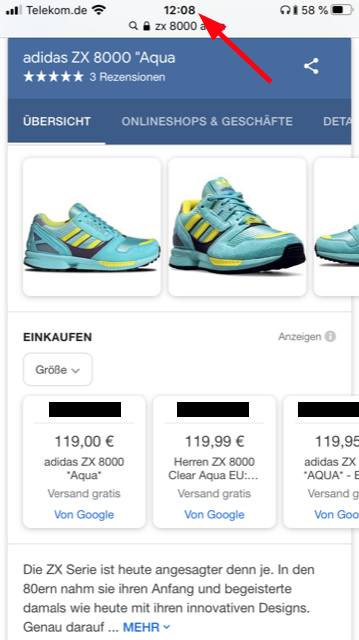
Anyone who knows us knows that we always strive to bring out the maximum in technical possibilities in order to enable the best possible user experience and thus not only to satisfy visitors, but consequently also our partner shops.
Sometimes, however, it is up to the dealer to use the options offered. Today’s release of the long-awaited adidas ZX 8000 Aqua shows why good feed management is important.

The problem: the demand exceeds the supply
A special feature of the sneaker market are releases, in which selected models are very limited and the demand exceeds. Many retailers use the releases to attract attention and announce the models early, often with a countdown and a reminder function. From a marketing perspective, this is clever – but if the demand clearly exceeds the supply, as in the example of the ZX 8000 Aqua, this can also lead to problems that cost money.
In contrast to other products – such as perfumes – a customer whose shoe size is sold out cannot simply switch to a smaller or larger version. That means every customer who was “bought” through a marketing channel, but whose size is no longer available, causes unnecessary costs. For this reason, it is important to update the availability via the marketing channels as fast as possible.
The rule is: the faster the better. This was particularly evident in “hype releases” such as today’s adidas ZX 8000 Aqua. The model was sold out in just a few minutes – but hours later you can still find it on various commercial channels, including Google Shopping:

This is not only annoying for the customer who wants to buy the model, but also causes unnecessary costs for the merchant – for a release that is in high demand, these costs can quickly reach a three- or even four-digit sum! The problem of “actuality of availability” does not only occur with releases, but also with sales campaigns or on special days like Black Friday!
The solution of the problem

As a solution to this, we offer a status API as a supplement to our main feed. With this API, sold out items (= sizes) can be communicated to us in real time, so that they can be taken offline with a delay of a few seconds at everysize!
The ZX 8000 Aqua showed us how important the status API is. All merchants who are already using the status API were able to maintain or even increase their (high in average) conversion rate, while merchants without a status API had a conversion rate that was significantly below the average. Contact us for the quick & easy implementation of the Status API.
Second problem: Coming-soon releases too early in the main-feed
Another mistake is to hand over the product in the product feeds of the marketing channels before the actual release date. This includes the everysize feed, but also all other channels such as Google Shopping, the Facebook Catalog Manager, price comparison and other shopping channels as well as affiliate feeds.
With the delivery in the feeds, the articles are usually published directly on the corresponding marketing channels and thus actively promoted. So visitors can find and click on the product, assuming that it is available. The retailer therefore incurs costs without the customer being able to buy the product he selected. When billing via CPC, the costs arise directly – in the affiliate channel you unnecessarily distribute cookies that indirectly cause a commission. Under certain circumstances, this can even lead to double billing – if the customer has a cookie already and makes the purchase via a CPC channel afterwards – this is a separate topic that I will write about in the future.
Even with this problem, three or four-digit costs can unnecessarily arise very quickly! These costs can be avoided with good feed management.
This is how good feed managment works
- Products that are not yet available for purchase should not be submitted to the marketing channel feed. All you have to do is adjust the rule with which the feed is generated. This must include the correct release date, which is stored in the shop or in the ERP (otherwise the countdown would not be possible) (… AND release_date = NOW ...)
- Alternatively, there is the option in the everysize feed to transfer the release date directly to the article level. In this case, we control the publication from our side. If, for example, a retailer hands over the release date “2020-01-03 09:00:00”, we will only put it live on the corresponding item at 9:00 on January 3rd, 2020 – exactly when the item is available in the shop. We are at your disposal for further information.
